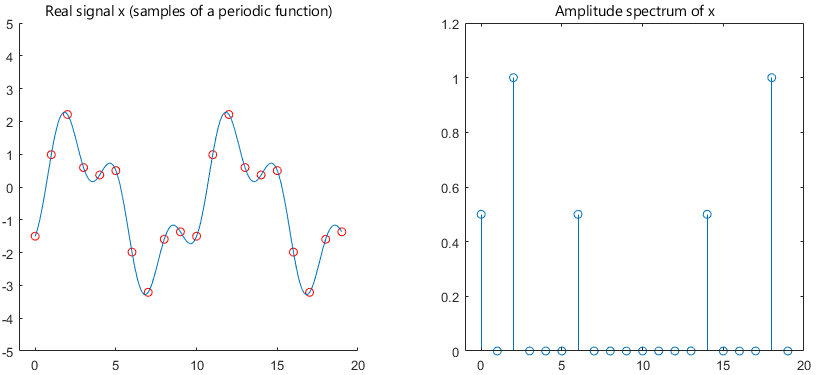This lecture discusses some important properties of the Discrete Fourier Transform of a real vector (signal).
In what follows, the Discrete Fourier Transform (DFT) of an
vector
is another
vector
whose entries
satisfy
where
is the imaginary unit.
We will repeatedly use some properties of complex conjugation, briefly reviewed here.
Remember that the complex conjugate of
is
The complex conjugate of a sum is equal to the sum of the
conjugates:
The complex conjugate of a product is equal to the product of the
conjugates:
The complex conjugate of a complex exponential
is
The DFT of a real signal enjoys the following conjugate symmetry property.
Proposition
Let
and
be two
vectors, such that
is the Discrete Fourier Transform of
.
If all the entries of
are real numbers,
then
for
.
First of all, we apply the rules of complex
conjugation:In
the last step, we have used the fact that the complex conjugate of a real
number is equal to the number itself. Then, we exploit some basic properties
of trigonometric
functions:
![[eq9]](/images/discrete-Fourier-transform-of-a-real-signal__21.png) Finally,
we put together the previous
results:
Finally,
we put together the previous
results:![[eq10]](/images/discrete-Fourier-transform-of-a-real-signal__22.png)
If the vector
is real, then the first entry of its DFT
(
)
is also real.
It suffices to set
in the DTF
formula:
The
result of the latter sum is real because all the summands are real by
assumption.
Consider the so-called Nyquist frequency
.
If
is an integer (i.e.,
is even) and the vector
is real, then the DFT entry
is also real.
By the conjugate symmetry property, we
haveBut
a complex number is equal to its conjugate only if it is real.
We now show a couple of numeric examples, where you can see that the properties above (conjugate symmetry, zero complex part for first and Nyquist entries) are satisfied.
In the first example
is even (equal to 8).
We mark symmetric terms with matching symbols.
| Signal x | DFT X (real part) | DFT X (complex part) | Comments and symmetry marks |
|---|---|---|---|
| 1.0000 | 10.0000 | 0 | First entry (no complex part) |
| 1.5000 | -0.4464 | -1.5364 | * |
| 1.7000 | 0.3000 | 0.1000 | @ |
| 1.3000 | -1.1536 | 0.2636 | $ |
| 1.8000 | 0.6000 | 0 | Nyquist folding (no complex part) |
| 0.8000 | -1.1536 | -0.2636 | $ |
| 0.8000 | 0.3000 | -0.1000 | @ |
| 1.1000 | -0.4464 | 1.5364 | * |
In the second example
is odd (equal to 9).
| Signal x | DFT X (real part) | DFT X (complex part) | Comments and symmetry marks |
|---|---|---|---|
| 0.5000 | 3.9000 | 0 | First entry (no complex part) |
| -0.2000 | -3.0670 | -0.3692 | * |
| -0.4000 | 1.7162 | 1.3334 | @ |
| 1.1000 | 1.2000 | -1.5588 | $ |
| 1.8000 | 0.4508 | 0.1438 | % |
| 0.7000 | 0.4508 | -0.1438 | % |
| 0.5000 | 1.2000 | 1.5588 | $ |
| 0.2000 | 1.7162 | -1.3334 | @ |
| -0.3000 | -3.0670 | 0.3692 | * |
When
is real, we can derive a frequency domain representation in terms of sines and
cosines:
if
is even, the representation
is
![[eq13]](/images/discrete-Fourier-transform-of-a-real-signal__37.png)
if
is odd, the representation
is
![[eq14]](/images/discrete-Fourier-transform-of-a-real-signal__39.png) where
where
denotes the floor of
.
The usual frequency-domain representation
is
We will transform it, by using the following property, derived in the proofs
above:![]()
When
is even, we have
![[eq18]](/images/discrete-Fourier-transform-of-a-real-signal__45.png) Therefore,
Therefore,![[eq19]](/images/discrete-Fourier-transform-of-a-real-signal__46.png) When
When
is odd, an almost identical derivation
yields
![[eq20]](/images/discrete-Fourier-transform-of-a-real-signal__39.png)
Note that in both cases (even and odd), the representation involves only the
first
entries of the DFT.
The remaining entries of the DFT (those corresponding to frequencies higher than the Nyquist frequency) are not used in the representation.
In other words, when
is real, the information about
enclosed in the DFT
is somehow redundant: the values of
beyond the Nyquist frequency are not needed to reconstruct
.
The
amplitude
spectrum is an
vector
whose entries are calculated
as
As a direct consequence of the conjugate symmetry property derived previously,
the amplitude spectrum of a real signal is symmetric around the Nyquist
frequency:![]() for
for
.
Here is an example.

The entries of the
power
spectrum
satisfy
Therefore, also the power spectrum is symmetric.
Please cite as:
Taboga, Marco (2021). "Discrete Fourier transform of a real signal", Lectures on matrix algebra. https://www.statlect.com/matrix-algebra/discrete-Fourier-transform-of-a-real-signal.
Most of the learning materials found on this website are now available in a traditional textbook format.